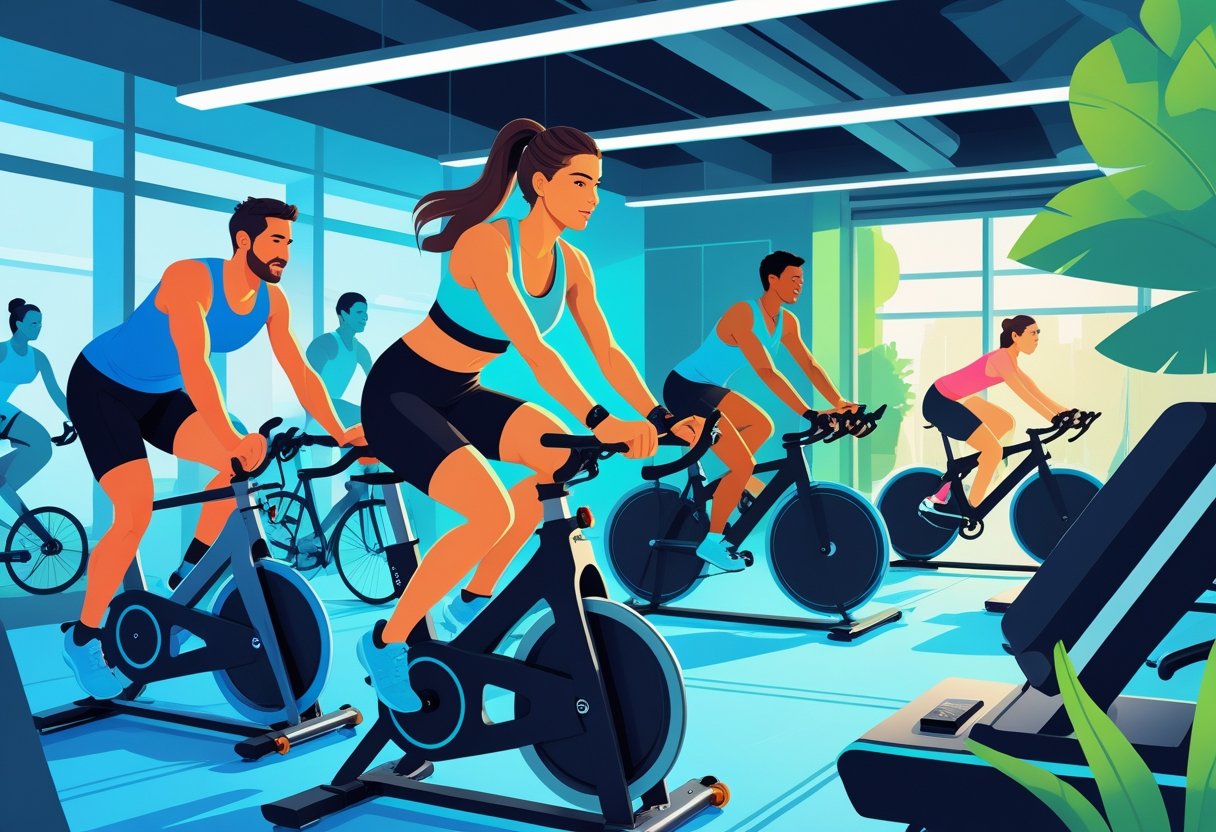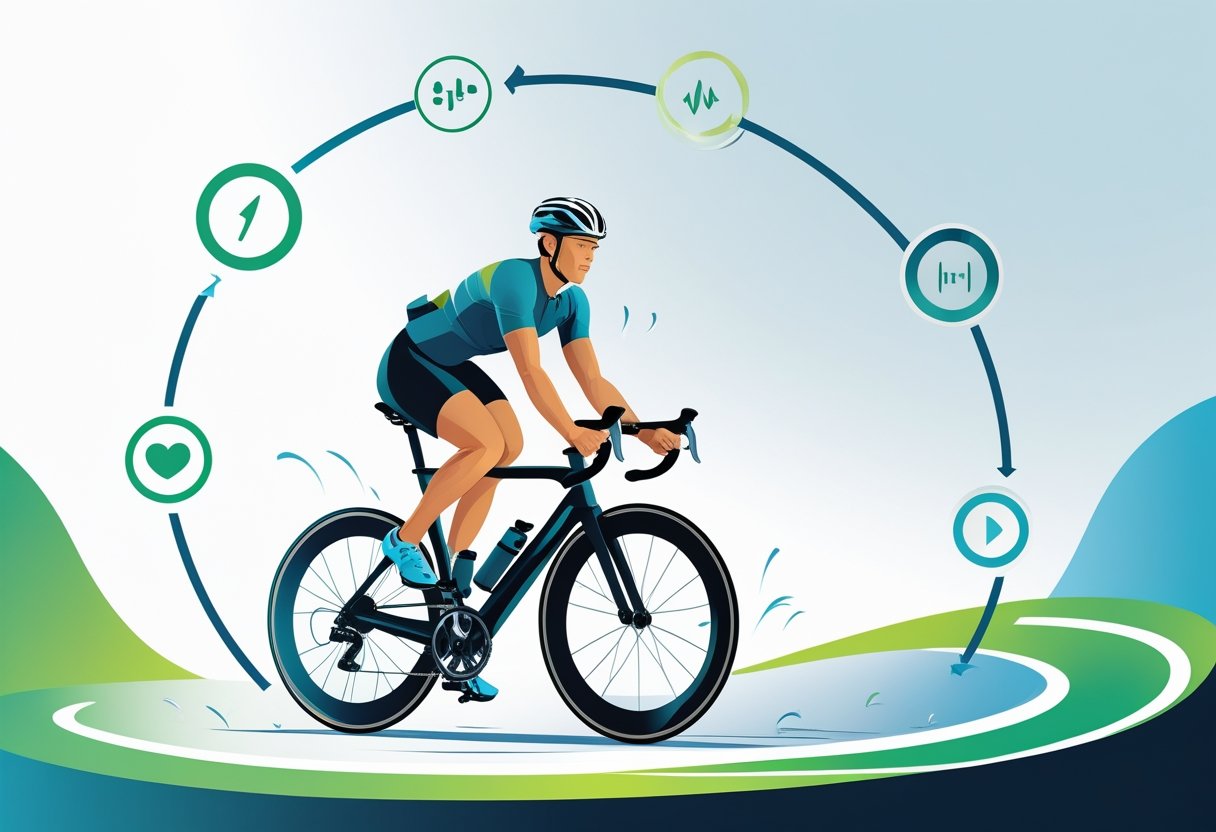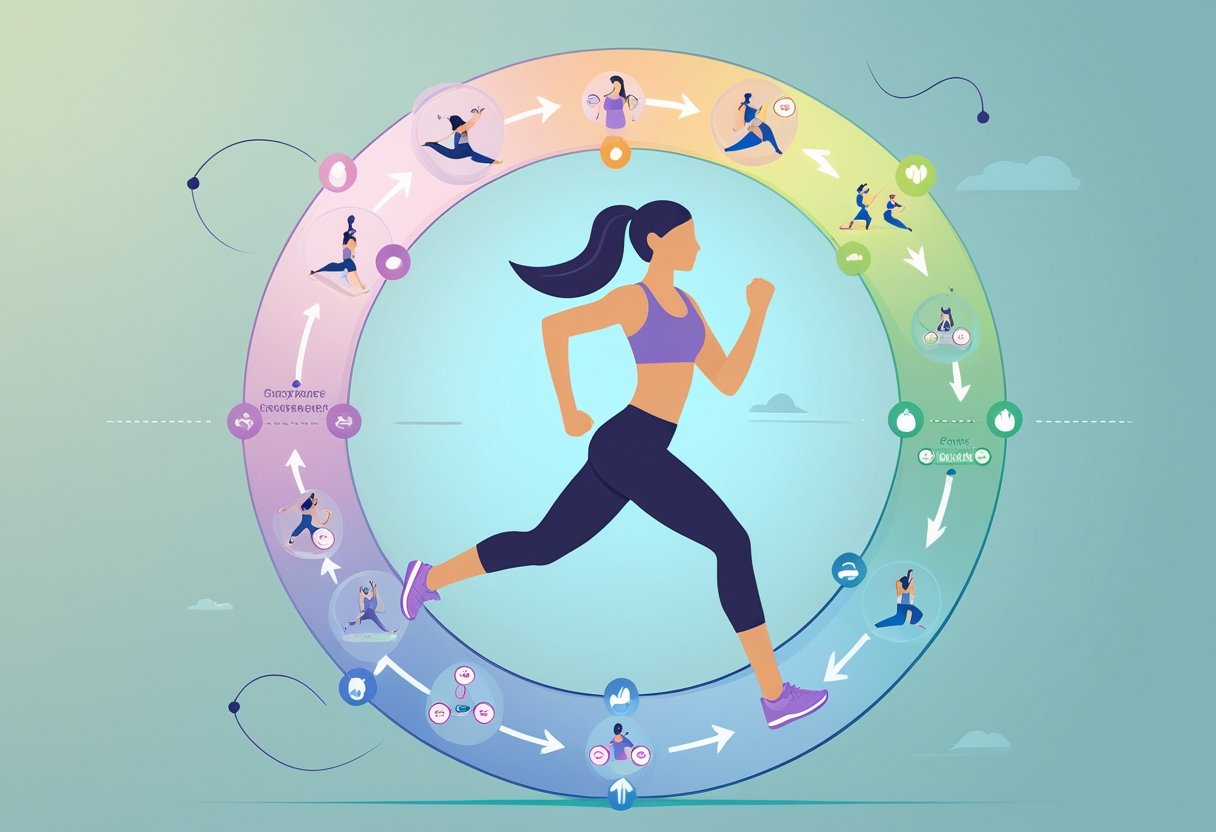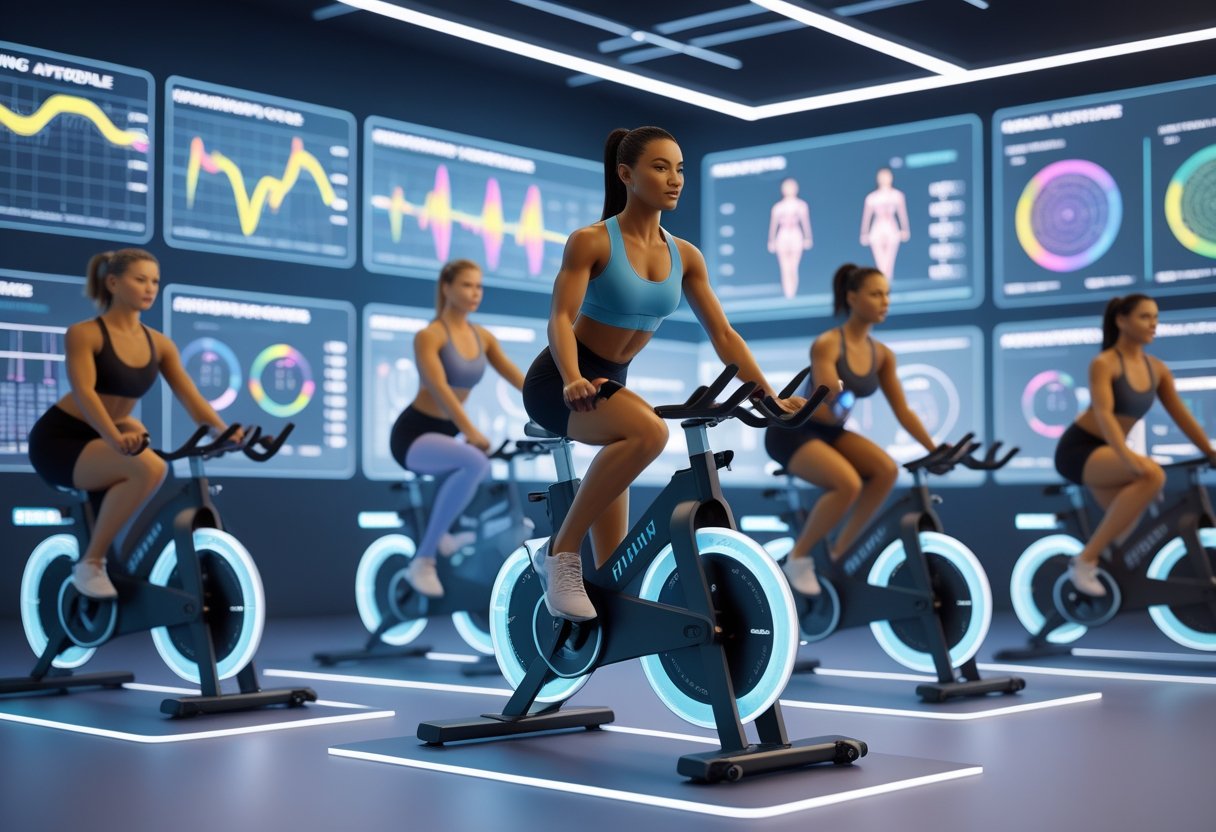Cycle-based fitness is an approach that matches exercise and nutrition plans with the phases of the menstrual cycle. By adjusting workouts and habits to the body's natural rhythms, people can support their energy, performance, and overall well-being. This method has gained attention for helping people feel more in tune with their bodies and get the most out of their fitness routines.

Each phase of the cycle brings changing hormone levels that can impact motivation, strength, and recovery. Cycle-based fitness considers these changes to help individuals choose the best times for intense activities, gentle movement, or extra rest. Tailoring fitness routines to the menstrual cycle can lead to better results and more balanced health.
Key Takeaways
- Cycle-based fitness adapts exercise to each phase of the menstrual cycle.
- Individual needs and hormone changes play an important role in workout choices.
- Tracking your cycle helps personalize and improve fitness results.
What Is Cycle-Based Fitness?

Cycle-based fitness is a health approach where women adjust workouts, nutrition, and daily routines to match hormone changes throughout their menstrual cycle. This practice encourages smarter training choices for better results, comfort, and well-being. The method draws from biology, sports science, and personal experience.
Defining Cycle-Based Fitness
Cycle-based fitness is the practice of matching exercise and nutrition to the different phases of the menstrual cycle. This method considers how the body’s hormones—such as estrogen and progesterone—change throughout the month.
There are four main phases: menstrual, follicular, ovulation, and luteal. Each phase affects energy, mood, and the body’s response to exercise. For example, a woman may have more energy and strength after her period and may feel more tired just before the next one begins.
By paying attention to these changes, women can use cycle syncing to make the most of high-energy days and rest or focus on lighter activities when needed. More people are adjusting their workouts and routines based on their cycles.
The Science Behind Cycle Syncing
Hormones play a central role in cycle-based fitness. Estrogen levels rise during the follicular phase, often leading to increased energy and better muscle recovery. This is a good time for strength training or intense cardio.
During ovulation, hormone levels peak, and many women find their performance improves further. After ovulation, in the luteal phase, progesterone increases. This hormone shift may lead to lower energy, bloating, or mood changes, making it an ideal window for gentler movement such as yoga, walking, or stretching.
Cycle syncing encourages people to listen to their bodies and respect hormone changes that impact endurance, recovery, and injury risk. Studies show that syncing workouts and nutrition with the menstrual cycle can support healthy training and help avoid burnout or overtraining.
Key Benefits and Importance
Cycle-based fitness offers several important benefits. It may help optimize performance and make exercise more enjoyable by working with the body’s natural patterns, not against them.
Women can often avoid unnecessary fatigue or injury by matching their training plan to their hormones. This approach also encourages a positive mindset and body awareness. Some users report feeling less frustration and more consistent progress when they follow a cycle syncing approach.
In addition, this method can be tailored to fit individual needs. People can switch exercise types or rest according to what feels best, and eating habits can be adjusted for energy and recovery. This makes cycle-based fitness a flexible and effective strategy for many women.
Understanding the Menstrual Cycle
The menstrual cycle affects the body’s hormones, energy, and mood. Each phase brings unique physical changes that impact exercise and daily life.
Phases of the Menstrual Cycle
The menstrual cycle has four main phases: menstruation, follicular phase, ovulation, and luteal phase.
- Menstruation starts the cycle and lasts about 3-7 days. The uterus sheds its lining, and hormone levels are low, which can lead to tiredness.
- Follicular phase begins after menstruation and can last until around day 14. Estrogen rises, which supports muscle growth and energy.
- Ovulation occurs around the middle of the cycle. An egg is released, and some people feel more energetic during this time.
- Luteal phase follows ovulation and lasts about 14 days. Progesterone increases, and some people feel bloated or notice mood changes.
Cycle syncing, or matching exercise to these phases, is gaining attention for helping people optimize their workouts. Learn more about tracking and adjusting fitness routines for each phase at this HealthPartners article.
Role of Hormones in Fitness
Hormones like estrogen and progesterone play a big role in fitness and energy.
Estrogen rises in the follicular phase, and people might notice more power and better endurance during this time. Ovulation, when estrogen peaks, can be the best time for strength training. The luteal phase, when progesterone is high, may bring more fatigue and slower recovery.
Matching workouts to these changes is called cycle syncing. For example, focusing on resistance or high-intensity training during high-estrogen days and lighter exercise during the luteal phase can help manage energy and lean muscle growth.
Hormone shifts also influence the body's metabolism and hydration needs, which means nutrition changes might also be helpful across the month.
Physical and Emotional Changes
Physical symptoms during the menstrual cycle include cramps, bloating, headaches, and changes in appetite. Some people may feel strong and full of energy, while others feel tired or weak, especially during menstruation or late in the luteal phase.
Emotional changes are common because hormone levels affect brain chemicals. Mood swings, irritability, or sadness can happen, especially as progesterone rises. Some feel confident and motivated near ovulation when estrogen peaks.
Understanding these changes helps with planning workouts and managing expectations. Cycle tracking can also give clues on when to adjust exercise, rest, or focus on self-care, which is discussed in more detail in studies like this Harvard Women’s Health Study update.
Optimizing Training for Each Cycle Phase
Energy levels, strength potential, and fatigue can shift based on the menstrual cycle phase. Adjusting exercise routines to match these changes helps support progress and reduce discomfort.
Exercise Guidelines for the Follicular Phase
The early follicular phase begins right after menstruation. Hormone levels, especially estrogen, start to rise. This rise often leads to increased energy and improved recovery.
Many people feel more motivated and stronger during this time. Cardiovascular exercises like running, swimming, or cycling feel easier. Including moderate to high-intensity workouts is recommended.
Strength training is especially effective here. The body builds muscle more efficiently, and the risk of injury is lower.
Try exercises such as squats, lunges, bench presses, and deadlifts.
Using a planned approach to training in this phase can help take advantage of higher energy and lower soreness. For more ideas, see this guide for cycle-based workout planning.
Recommended Routines During Ovulation
Ovulation usually happens around the middle of the cycle. Estrogen is at its highest. Physical performance often peaks.
Short, intense workouts work well right now. Examples include sprinting, HIIT, and plyometric drills. Strength gains and power are often easier to achieve. Sports or activities that require speed and skill may also feel easier.
Sample Weekly Ovulation Workout:
- Day 1: HIIT session
- Day 2: Plyometrics (box jumps, burpees)
- Day 3: Sport-specific drills (basketball, tennis)
Staying aware of extra joint mobility is important, as the risk of strains can rise due to hormonal changes. Warming up and using proper form help prevent injuries. Learn more about performance changes during ovulation.
Strength Training in the Luteal Phase
The luteal phase starts after ovulation. Progesterone rises and some may notice more fatigue and bloating.
It helps to lower workout intensity and focus on form. This is a good time for moderate strength training and low-impact cardio. Yoga and pilates are also supportive options when energy dips.
Effective Luteal Phase Strength Focus:
- 2-3 sets with moderate weight
- 8-12 reps per exercise
- Include rest between sets
Consistency matters more than intensity during this phase. Pay attention to fatigue and adjust sessions as needed. For more information on how to optimize training during the luteal phase, experts suggest planning lighter routines.
Fitness Adjustments During Menstruation
Menstruation marks the start of a new cycle. Many feel lower energy, cramps, or discomfort. It is important to listen to the body and adjust exercise routines as needed.
Gentle movement such as walking, stretching, or light yoga can help ease menstrual symptoms. It is okay to skip high-intensity workouts if cramps or fatigue are bad.
Menstruation-Friendly Activities:
- Walking
- Gentle flow yoga
- Light stretching
Strength training is still possible if energy allows, but using lighter weights and shorter sessions is advised. Hydration and rest are important as well. Learn more about how to safely adapt workouts during menstruation.
Adapting Workouts and Recovery
The menstrual cycle can affect energy levels, muscle recovery, and how the body responds to exercise. Adjusting workout routines to account for these changes can help manage fatigue, support growth, and protect sleep quality.
Modifying Intensity and Duration
Workout intensity and length may need to change during different phases of the cycle. For example, in the follicular phase, many people feel higher energy and may benefit from longer, more intense sessions like HIIT or resistance training. This is a great time to focus on muscle growth and building strength.
During the luteal phase, some experience more fatigue or lower stamina. At this time, reducing intensity and switching to lower impact activities can be helpful. Shorter, moderate workouts are still effective and can help maintain consistency. A cycle-based approach helps people stay active while working with their body's natural rhythms.
Balancing Rest and Recovery
Quality rest is vital for muscle repair and growth, especially when hormone levels change. When the body feels tired, adding extra recovery days or using active recovery, like walking or gentle stretching, can prevent burnout. Prioritizing good sleep can speed up physical recovery and help manage stress.
Tracking sleep patterns and listening to the body is important. If a person notices more soreness or less motivation, cutting back on intensity for a few days may help. Physical therapists suggest adapting exercise plans based on energy levels and fatigue, which can support long-term consistency.
Mobility and Flexibility Strategies
Mobility and flexibility work can improve movement and reduce injury risk throughout the cycle. In phases where muscles feel tighter or the body is less energetic, spending more time on dynamic stretching or yoga can boost range of motion.
A mix of static and dynamic stretches helps different muscle groups recover and grow. Low-impact mobility routines allow people to stay active without overloading the body. These strategies make it easier to manage soreness, increase energy, and maintain regular workouts no matter the time of the month.
Hormonal Effects on Fitness and Motivation

Fluctuations in hormone levels shape energy, muscle strength, and mental drive throughout the menstrual cycle. Key hormones like estrogen and progesterone can impact exercise results and emotional well-being in different ways.
Impact of Estrogen and Progesterone
Estrogen and progesterone rise and fall in predictable patterns during the menstrual cycle. Higher levels of estrogen during the ovulatory phase can help the body use energy more efficiently, boost muscle growth, and improve peak power output, which may support better exercise performance.
Progesterone increases after ovulation and peaks in the luteal phase. Elevated progesterone is linked with shifts in body temperature and fluid retention. Some people may feel more fatigued or experience decreased physical output during this time, affecting both endurance and strength.
Tracking these hormone changes gives athletes useful information. By adjusting workouts to match these phases, it may be possible to get more from each session while avoiding overtraining or unnecessary fatigue.
Mood, Motivation, and Emotional Wellbeing
Hormones play a key role in shaping mood and motivation. During the ovulatory phase, many people report higher motivation to compete and train, along with improved self-confidence and energy. These changes line up with periods of high estrogen, which can boost neurotransmitters linked to happiness and drive.
On the other hand, progesterone’s rise in the luteal phase may be connected to mood swings, trouble focusing, and lower motivation. Emotional wellness can also be affected, leading to feelings of irritability or sadness for some.
Keeping track of these patterns can help individuals plan workouts more effectively and understand changes in their own motivation or mood. Using a journal or app might make it easier to spot these connections and adjust fitness goals to fit the body’s natural cycles.
Nutrition and Lifestyle Support
A person’s energy, recovery, and physical development can shift during different times in a menstrual cycle. Adjusting nutrition, sleep, and stress management helps support the body’s natural growth and performance patterns.
Nutritional Considerations by Cycle Phase
Nutritional needs change throughout each phase of the cycle. In the follicular phase, lighter meals with lean proteins, whole grains, and leafy greens can help improve energy and support muscle growth. Many find that complex carbs, like quinoa and brown rice, maintain steady blood sugar levels during this time.
During ovulation, protein and antioxidant-rich foods, such as salmon and berries, can support muscle repair and overall development. The luteal phase often brings lower energy and increased cravings. Nutrient-dense snacks, including nuts and seeds, can help manage hunger and support hormone balance.
Iron-rich foods are important after menstruation, helping to rebuild lost stores and support healthy growth. For even more tips on aligning food choices with each phase, visit this in-depth guide on cycle syncing nutrition.
Sleep, Stress, and Recovery
Sleep requirements may shift during different cycle phases. For instance, deeper rest is often needed in the luteal and menstrual phases, when the body uses more energy for repair and recovery. Sticking to a regular sleep schedule and creating a calming bedtime routine helps improve rest.
Stress can impact hormone levels and slow physical progress. Techniques like gentle yoga, meditation, or even short walks can reduce tension and support recovery. Taking rest days in line with energy dips helps the body adapt and build strength.
Focusing on both sleep and stress management aids growth, muscle repair, and balanced mood. More information on these cycle-based strategies can offer additional practical ideas for daily life.
Cycle-Based Fitness for Different Life Stages
Cycle-based fitness can benefit people at many points in life. This approach helps those going through puberty and those who are experiencing menopause manage changes in their bodies and feel supported in their health goals.
Adapting for Adolescents and Young Adults
During adolescence, hormonal changes can affect mood, energy, and physical performance. At this age, the menstrual cycle begins, and tracking it can help young people adjust workout intensity and type.
Key points:
- Early cycle (follicular phase): Most teens may notice higher energy levels. It is a good idea to schedule more intense cardio or strength workouts.
- Later cycle (luteal phase): Energy may dip, and focusing on gentle activities like walking, stretching, or yoga can support recovery and well-being.
- Development: Adjusting fitness routines to match cycle phases supports bone health, builds positive exercise habits, and helps manage symptoms like cramps or fatigue.
Using a fitness journal or app can help adolescents and young adults track changes and plan workouts that fit their needs each week.
Fitness Strategies Through Menopause
Menopause marks the end of the menstrual cycle and brings changes in hormones like estrogen and progesterone. These changes can affect muscle mass, bone density, and metabolism.
Important adjustments include:
- Strength training: Lifting weights helps maintain muscle and bone health, which become more important as estrogen levels drop.
- Low-impact cardio: Activities such as swimming or biking are gentler on joints and help with heart health.
- Flexibility and balance exercises: Yoga and stretching reduce stiffness and lower the risk of injuries.
Some people may notice new patterns in their energy or comfort. Adapting workouts to current symptoms, such as hot flashes or fatigue, helps create a sustainable routine during menopause. Setting realistic goals and staying consistent are both key for long-term health at this stage.
Tracking and Personalizing Your Approach
Tracking the menstrual cycle helps people understand body changes and make smarter choices about when and how to exercise. Customizing fitness plans can improve motivation and comfort, making workouts more effective and enjoyable.
Monitoring the Menstrual Cycle
To get started, many use period tracking apps or simple calendars. These tools help map out the cycle and make it easier to spot patterns in energy, mood, or motivation. For example, users can record physical symptoms, sleep quality, or daily mood to detect trends over time.
Tracking makes it easier to notice which parts of the month bring higher energy or when rest would be more helpful. Many apps, like MyFlo and Period Tracker Lite, allow users to log symptoms and get reminders about upcoming changes. Even smart devices, like fitness trackers, can help by monitoring sleep or heart rate for deeper insights as seen with options like the Oura Ring.
Consistent tracking is the foundation of cycle syncing, helping people spot which workouts feel best at different times. This routine works for many, but it may take a few cycles to see clear patterns.
Customizing Fitness Plans
Once someone has tracked their menstrual cycle and noticed patterns, they can adjust their exercise routines to match each phase. For example, higher energy right after a period may make it a good time for strength training or higher-intensity workouts.
In contrast, the days during or before menstruation may call for lighter activities, like yoga or walking. Flexibility and adaptability are important—some people may feel more motivated during certain times, while others prefer more rest and gentler movement.
A simple way to organize workouts is to break them down by cycle phase:
| Phase | Suggested Workouts |
|---|---|
| Menstruation | Stretching, gentle yoga, walking |
| Follicular | Cardio, endurance, strength |
| Ovulatory | High-intensity, group classes |
| Luteal | Pilates, low-impact, moderate |
Personalizing workout plans based on these trends can help improve consistency and make fitness routines more enjoyable. Using cycle syncing as part of fitness helps many people stay motivated and feel in control of their exercise routines (learn more).
Frequently Asked Questions
Many people want to understand how cycle-based fitness works day to day. Questions about food, workouts, digital tools, benefits, and finding support are common.
How does one incorporate cycle syncing into a fitness routine?
Cycle syncing means adjusting workouts to match the body's hormonal changes during each menstrual phase. For example, higher energy levels in the follicular phase may support more intense workouts, while lower energy during the luteal and menstrual phases might call for lighter movement like yoga or walking.
Keeping a log or using an app to track symptoms and performance can help fine-tune activity choices. This makes it easier to notice how different workout types feel at different times of the month.
What are the best foods to consume for optimizing cycle-based fitness?
Eating with the menstrual cycle often means focusing on whole foods and getting enough protein, healthy fats, complex carbs, and fresh fruits and vegetables. During the follicular phase, many choose lighter, fresh foods, while in the luteal phase, foods rich in magnesium and fiber may help with cravings and bloating.
Including iron-rich foods around menstruation may help replace iron lost during periods. Adjusting nutrition based on energy and symptoms can support exercise efforts.
Can you provide examples of workouts tailored for different phases of the menstrual cycle?
High-energy workouts such as HIIT, strength training, or cardio often fit best during the follicular and ovulation phases. During the luteal phase, swapping in moderate-intensity activities or Pilates may be more comfortable.
Menstruation is a good time for gentle movement, like stretching or walking, though some people still enjoy regular exercise depending on how they feel. More details on how movement and the menstrual cycle connect can be found through this cycle syncing Q&A.
Are there any fitness apps that support cycle syncing methodology?
Several fitness and period tracking apps support cycle syncing. These let users enter data about symptoms, mood, and energy, and can suggest workouts or meal plans based on cycle phase.
The 28 app offers structured guidance for syncing fitness and nutrition with the menstrual cycle. Many mainstream apps like Clue and Flo have tracking and educational features related to exercise and menstruation.
What are the benefits of aligning exercise routines with menstrual cycle phases?
Tuning workouts to the menstrual cycle may help reduce fatigue, prevent burnout, and boost enjoyment. Some people report improved performance, fewer injuries, and better recovery when following this approach.
Scientific reviews find that some women exercise more consistently and feel more satisfied with their routines when they tailor their workouts to their cycles. More information on exercise habits and menstrual phases is available from Harvard’s research.
Where can I find community support for cycle-based fitness programs?
Online platforms, group classes, and forums are good sources for advice and motivation. Some websites have dedicated communities for people interested in learning about movement, nutrition, and lifestyle based on their cycles.
Social media groups and women’s health platforms like Obe Fitness offer discussions, Q&As, and personal stories from people practicing cycle-based fitness. This helps create a sense of support and shared experience.
Conclusion
Cycle-based fitness can help people match their workouts and habits to their menstrual cycle. This approach is based on changes in energy, hormone levels, and strength throughout the month.
Many find that tailoring workouts to each cycle phase may help support motivation and comfort. Simple adjustments—like lighter workouts during the early follicular phase—may reduce fatigue and stress for some people. Research shows exercise performance might be slightly lower during this phase, so listening to the body can help (The Effects of Menstrual Cycle Phase on Exercise Performance).
Possible benefits of cycle-based fitness include:
- Improved workout consistency
- Reduced injury risk
- Better energy management
Cycle syncing is a growing trend. It encourages individuals to change exercise routines, diet, and lifestyle habits in line with their cycle (Cycle Syncing to Connect with Your Body). This can help people feel more in control and stay engaged with fitness.
Each body is different. What works for one person may not work for another. Anyone interested in cycle-based fitness should try small changes first, see how their body responds, and consult a healthcare provider if needed.

